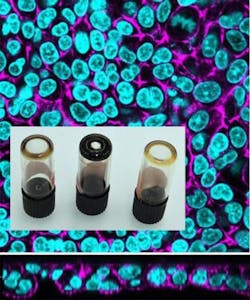Fluorescence-emitting nanodots provide clues on how air pollution affects health
Seeking to learn more about the mechanisms behind how air particulates affect human health, a team of researchers at the University of Fribourg (Fribourg, Switzerland) and the International Iberian Nanotechnology Laboratory (Braga, Portugal) has developed a fluorescence method to investigate how carbon-based combustion byproducts behave as they interact with human epithelial tissue. The researchers discovered that the surface properties of the carbon nanodot's properties and aggregation patterns affected their distribution in a lab-grown copy of the epithelium. The carbon nanodots served as representatives for air pollution particles.
"Localization and quantification of inhaled carbon nanoparticles at the cellular level has been very difficult," says Barbara Rothen-Rutishauser, an author on the paper. "We now have a model fluorescent particle that can try to answer questions about the fate of ultrafine particles in the lung."
At <100 nm in diameter, air particulates have the small size and large relative surface area to wreak havoc on cells and potentially enter the bloodstream. Other groups' research has shown that ultrafine particles induce adverse effects on the lungs and cardiovascular system by increasing oxidative stress in the body.
Because of particle size, it is difficult for lab techniques to distinguish between carbon in pollutants from carbon in tissues. Therefore, little is known about surface charge and states of agglomeration—two key physical and chemical features that affect how carbon particles interact with living tissues.
To begin modeling ultrafine particles, Estelle Durantie, another author of the study, turned to fluorescent carbon nanodots doped with nitrogen and a combination of nitrogen and sulfur with different sizes and charges. The team then applied these nanodots to the top layer of a lab-grown epithelial tissue, where gas exchange typically happens in the lung.
Dispersion behavior and agglomeration state of carbon nanodots and light sheet microscopy images of co-cultures exposed to nanodots are shown. (Image credit: Estelle Durantie and Hana Barosova)
Since regular fluorescence microscopes lack the resolution to visualize such small particles, the group used spectroscopy and ultraviolet (UV) light to detect and quantify nanodots as they migrated from the luminal compartment past their lung model's immune cells. As the researchers expected, charged particles tended to stick together before penetrating the gas-exchange barrier. While most of the neutrally charged nanodots passed through the tissue after only an hour, only 20% of the agglomerated charged particles infiltrated the epithelium.
Rothen-Rutishauser says she hopes to further improve nanodots so that they better mimic ultrafine particles. "What we're seeing is that translocation depends on aggregation state," she says. "We hope to continue trying out different sizes of nanodots, including other types of particles that get us closer to the real environment."
Full details of the work appear in the journal Biointerphases.
